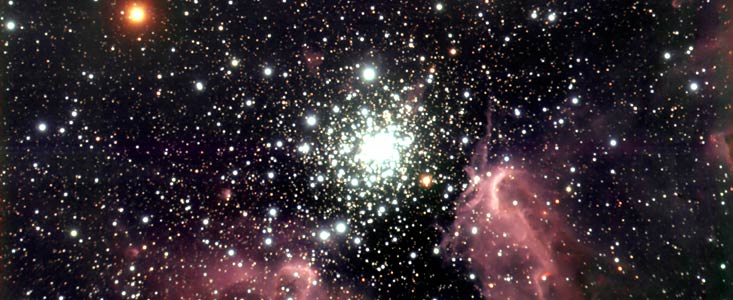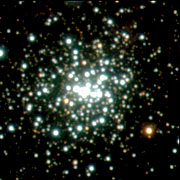Press Release
Lots of Small Stars Born in Starburst Region
Decisive Study of NGC 3603 with the VLT and ISAAC
13 October 1999
An international group of astronomers [1] has used the ESO Very Large Telescope (VLT) at Paranal (Chile) to perform unique observations of an interstellar nebula in which stars are currently being born.
Thanks to the excellent imaging properties of the first of the four 8.2-m VLT Unit Telescopes, ANTU, they were able to demonstrate, for the first time, the presence of large numbers of small and relatively light, new-born stars in NGC 3603, a well-known "starburst" region in the Milky Way Galaxy .
Until now, it has only been possible to observe brighter and much heavier stars in such nebulae. The new observations show that stars of all masses are being born together in the same starburst event, a fundamental result for our understanding of the very complex process of star formation.
Background of the project
The present research programme was granted observing time with VLT ANTU in April 1999. Its general aim is to investigate collective, massive star formation, in particular the coalescence of high- and low-mass stars in the violent environments of starburst regions . These are areas in which the processes that lead to the birth of new stars are particularly active just now.
Several fundamental questions arise in this context. A very basic one is whether low-mass stars form at all in such environments. And if so, do they form together with the most massive stars in a starburst event or do they form at different times, before or after or perhaps on different timescales? Are low-mass stars born with any "preferred" mass that may possibly give further clues to the ongoing processes?
All of this is most important in order to understand the detailed mechanisms of star formation. Most current theoretical scenarios explain how single stars form in an isolated, contracting gas cloud, but most stars in the Universe did not form in that simple way. Once some massive stars have formed in some place and start to shine, they will quickly affect their environment, but how much? At this moment, nobody knows for sure what determines the actual masses of individual stars that are formed in a very massive and turbulent gas cloud, although some ideas can now be tested with these new observations.
The NGC 3603 region
The new VLT observations are the key part of a larger research programme that also includes observations of the stellar cluster in the famous Tarantula Nebula in the Large Magellanic Cloud (LMC) with the NICMOS instrument on the Hubble Space Telescope (HST), as well as adaptive optics observations with ground-based telescopes of more quiescent, star-forming regions in the Galaxy.
However, the team considered the starburst region NGC 3603 as the best target for this kind of investigation. It is situated in the far southern constellation Carina (The Keel) and can only be observed from the South. Moreover, such a study has to focus on the densest part of the cluster that can only be resolved with a very sensitive infrared (IR) instrument under the best seeing conditions. The VLT ANTU telescope and the multi-mode ISAAC facility are ideally suited for this purpose.
NGC 3603 is located in the Carina spiral arm in the Milky Way galaxy at a distance of about 20,000 light-years (6 - 7 kpc). It is the only massive, galactic "HII-region" (so denoted by astronomers because part of its hydrogen is ionized) in which a central cluster of strongly UV-radiating stars of types "O" and "B" that ionize the nebula can be studied at visual and near-infrared wavelengths. This is because the line-of-sight is reasonably free of dust in this direction; the dimming in near-infrared radiation due to intervening matter between the nebula and us is only about a factor of 2 (contrary to 80 in visible light).
The total mass of the hot O- and B-stars in NGC 3603 is over 2000 solar masses. Together, the more than fifty heavy and bright O-stars in NGC 3603 have about 100 times the ionizing power of the well-known Trapezium cluster in the Orion Nebula . In fact, the star cluster in NGC 3603 is in many respects very similar to the core of the large, ionizing cluster in the approx. eight times more distant Tarantula Nebula in the LMC.
The new VLT observations
Images of the NGC 3603 region were obtained in three near-IR filter bands (J s, H and K s) with the ISAAC instrument at the ANTU telescope. The observations were made in "service" mode on April 4 - 6 and 9, 1999, during selected periods when the (optical) seeing was equal to or better than 0.4 arcsec. This was a most essential requirement in order to achieve sufficient angular resolution (image sharpness) that would allow to do accurate photometric measurements of individual stars in this crowded cluster . This particular observing mode, during which ESO observers at ANTU kept careful track of the actual atmospheric conditions, contributed greatly to securing the very high quality images needed for this programme.
In view of the many comparatively bright stars in the field, the observing strategy was to use the shortest possible exposure time (1.77 sec) to keep the number of over-exposed (saturated) stellar images to a minimum. As the minimum time required to stabilize the telescope's active optics control system and guarantee the optimum optical quality was about 1 min, thirty-four short exposures were made at each sky position and then co-added to an effective one-minute exposure. After each such series, the telescope pointing was offset in a random pattern up to 20 arcsec from the center; this enlarged the imaged sky area somewhat and facilitated the subtraction of the infrared emission from the sky background.
The individual 1-min exposures were then very carefully co-aligned to obtain the highest possible spatial resolution and co-added. The resulting images cover a sky field of 3.4 x 3.4 arcmin 2 with a pixel size of 0.074 arcsec. The effective exposure times of the final broad-band images in the central 2.5 x 2.5 arcmin 2 area are 37, 45, and 48 min in the J s, H and K s filters, respectively.
The final step involved the computer-aided detection of the individual stars in the frames, the measurement of their brightness as seen in the different wavebands and hence their infrared colours. About 20,000 intensity peaks were detected in each waveband at the same pixel location. However, after the rejection of very faint and spurious images and recording only objects that were detected independently in all three wavebands within the same pixel, the resulting list of measured stellar images was reduced to 6967 objects, still a substantial number, though.
The brightness and colours of a star are an indication of its mass and age. By comparing the measured brightness and colours with computer simulations, the astronomers were therefore able to deduce the numbers of stars with different ages and masses in NGC 3603.
Detecting the low-mass stars in NGC 3603
The new VLT observations are the most sensitive ones made to date of this densely packed starburst region. They allowed the team to investigate in unprecedented detail the low-mass stellar population in this area.
Although the low-mass stars in NGC 3603 are not exceedingly faint - they are in fact about 3 magnitudes brighter than ISAAC's detection limit - it is extremely difficult to detect them and to measure their brightness accurately because of the enormous range of brightnesses (more than a factor of 10,000) among the densely crowded stars in the inner region of the cluster. Unless high angular resolution, high optical stability and high overall sensitivity is achieved, the fainter images of the low-mass stars will "drown" in the light of the adjacent, much brighter stars. Only a powerful telescope/instrument combination like ANTU/ISAAC can successfully perform such a critical observation.
The sensitivity limit obtained - set by the requirement that a star must be detected in all three infrared wavebands - corresponds to about one-tenth of a solar mass for young stars (in the astronomical sense) aged only 700,000 years, and still in the initial contraction phase. Thus, for the first time, it was possible to reach the necessary angular resolution and sensitivity to study a starburst region on a star-by-star basis down to this low mass limit. For comparison, the most sensitive observations of the more distant Tarantula Nebula only reach down to a limit of about 1 solar mass.
A most important conclusion of this study is that there are lots of sub-solar mass stars in NGC 3603 , i.e., contrary to several theoretical predictions, these low-mass stars do form in violent starbursts !
The overall age of stars in the contraction phase that are located in the innermost region of NGC 3603 was found to be 300,000 - 1,000,000 years. The counts clearly show that this cluster is well populated in sub-solar mass stars.
The next steps
The team describes these new results in a scientific article ("Low-mass stars in the massive HII region NGC 3603 - Deep NIR imaging with ANTU/ISAAC") that will appear in the European research journal Astronomy & Astrophysics in December 1999. Further information about related work on NGC 3603 is available at a dedicated webpage.
The present VLT data will now be used for continued studies during which the limits of detection and measurement will be further pushed by means of advanced image processing and analysis.
It will also be interesting to look further into possible variations of the number of stars with a given mass over the observed field, not least, to compare the new results with other ongoing studies of different regions (although less massive), e.g. with the Hubble Space Telescope and its infrared instrument NICMOS or with ground-based Adaptive Optics instruments.
Notes
[1] The team consists of Bernhard Brandl (Principal Investigator; Cornell University, Ithaca, New York, USA), Wolfgang Brandner (University of Hawaii, Honolulu, USA), Frank Eisenhauer (Max-Planck-Institut für Extraterrestrische Physik, Garching, Germany), Anthony F.J. Moffat (Université de Montreal, Canada), Francesco Palla (Osservatorio Astrofisico di Arcetri, Florence, Italy) and Hans Zinnecker (Astrophysikalisches Institut Potsdam, Germany).
[2] Proplyd is an astronomical term that stands for "proto-planetary disk", i.e. disks around young stars in which planets may later form. However, although they look like the proplyds found in the Orion Nebula, the "proplyd-like" objects in NGC 3603 are not likely to develop into planets.
About the Release
| Release No.: | eso9946 |
| Legacy ID: | PR 16/99 |
| Name: | NGC 3603 |
| Type: | Milky Way : Star : Grouping : Cluster : Open Milky Way : Nebula : Type : Star Formation |
| Facility: | Very Large Telescope |
| Instruments: | ISAAC |
| Science data: | 1999A&A...352L..69B |


